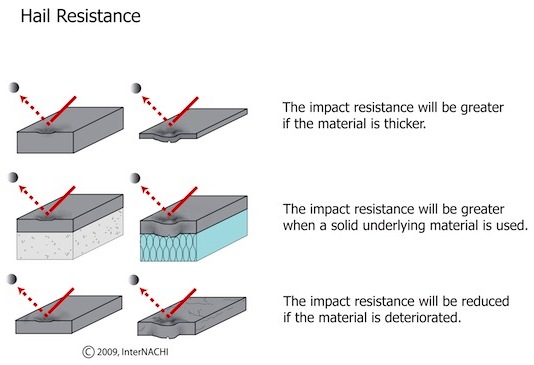Mastering Roof Inspections: Asphalt Composition Shingles, Part 48
by Kenton Shepard and Nick Gromicko, CMI®
The purpose of the series “Mastering Roof Inspections” is to teach home inspectors, as well as insurance and roofing professionals, how to recognize proper and improper conditions while inspecting steep-slope, residential roofs. This series covers roof framing, roofing materials, the attic, and the conditions that affect the roofing materials and components, including wind and hail.
Material Properties
When you inspect a home for hail damage, you’ll be looking at components made of a variety of materials with different properties. These properties affect the severity of hail damage.

- Hard surfaces resist damage better than soft surfaces.
- Flexible materials absorb impact-energy and resist damage better than brittle materials.
- Surfaces that are well-supported resist damage better than poorly supported surfaces.
- Thicker material resists damage better than thinner material.
- Horizontal surfaces are more likely to be damaged than vertical surfaces because the angle of impact will be closer to 90°.
Intentional Damage
Not all damage that appears to have been caused by hail was actually inflicted by hail. Although it’s not always necessary to identify the source of damage, it’s important that you are able to differentiate between hail damage and damage from other sources.
Although it’s rare, people have been known to use a number of different devices to try to replicate hail damage in an effort to fool insurance companies into paying for a new roof.
One way to spot these attempts is to look at the overall pattern of damage across the roof. Real hail impact is random. Intentional damage often has certain recognizable patterns.

Intentional damage is usually concentrated in certain areas, generally away from the roof's edges. People who create damage may be nervous about falling off the roof, so they stay closer to the roof's interior, where they feel safer.


Intentional damage across the roof may form a recognizable pattern, such as an arc. It may appear in separated groups because the person creating the damage has hit different parts of the roof from the same convenient position.

Real hail damage does not always occur in the center of a shingle. Real hail may hit any part of a shingle, including the edge of the tabs and in the notch. Hailstrikes may overlap. Intentional damage is often located toward the middle of the tabs and with no more than one hit per tab.
In checking for intentional damage, you should first look at the overall roof for patterns that indicate intentional damage. If you find such suspicious patterns, you should look more closely at the individual damage marks for further evidence.

In looking closely at damage, you should be looking right down into the bottom of the indentation at the condition of the granules. Hailstones do not crush granules when they strike asphalt shingles. Instead, hailstones typically remove granules from the sides of the impact and force granules toward the center of the impact, deeper into the asphalt layer. This is a key point in differentiating hail damage from other types of damage.
Hailstone impact will not crush granules, but the impact from steel often will, though not always.

The photo above shows two strikes with a ball-peen hammer. The upper strike was made at a 90° angle to the shingle's surface. The granules were pressed further into the asphalt, but not crushed. The lower strike was made with a glancing blow, and you can see that the granules were crushed.
Because granules are made from light-colored stone which has had a colored ceramic coating applied, crushed granules typically look like a light-colored powder, no matter what the color of the granules is.


They show the color of the stone, not the color of the coating.
**************************************************
Learn how to master a roof inspection from beginning to end by reading the entire InterNACHI series: Mastering Roof Inspections.
Take InterNACHI’s free, online Roofing Inspection Course
Mastering Roof Inspections
Roofing Underlayment Types
Inspecting Underlayment on Roofs
Fall-Arrest Systems
Roofing (consumer-targeted)
More inspection articles like this

